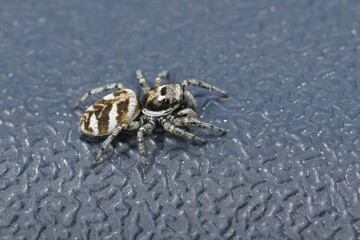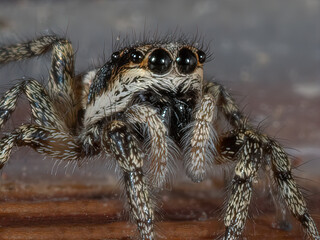Table of Contents
Scientific Classification
| Kingdom | Animalia |
| Phylum | Arthropoda |
| Class | Arachnida |
| Order | Araneae |
| Family | Salticidae |
| Genus | Salticus |
| Species | Salticus scenicus |
| Scientific Name | Salticus scenicus |
Description
The Zebra Spider (Salticus scenicus) is a small jumping spider known for its distinctive black-and-white striped pattern, reminiscent of a zebra’s markings. It is part of the Salticidae family, which is recognized for its excellent vision and unique hunting abilities. Typically measuring between 5-9 mm in length, females tend to be larger than males. The spider’s body is covered in fine hairs, and it has eight legs that are specially adapted for swift and precise movements, with the front pair being slightly longer to assist in capturing prey.
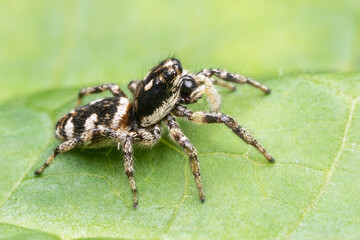
Distribution
Zebra Spiders can be found in various locations, including North America, Europe, and parts of Asia. Their adaptability allows them to thrive in diverse environments, such as urban areas and natural settings. You can often spot them in gardens, on walls, fences, tree trunks, and windowsills, where they patiently wait for their next meal.
Habitat
These spiders thrive in dry, sunny spots where they can hunt actively during the day. Rather than spinning webs to trap their prey, they rely on their impressive jumping abilities to ambush insects. Zebra Spiders are commonly found in rocky terrains, open fields, and even in human environments such as brick walls and fences. Their skill in climbing vertical surfaces allows them to navigate a variety of habitats.
Diet
Zebra Spiders primarily feed on small insects. Their diet consists of flies, mosquitoes, and various other arthropods. They rely on their sharp eyesight to track down prey before striking with accuracy. While their venom is harmless to humans, it effectively immobilizes their catch in no time. Unlike web-spinning spiders, Zebra Spiders are active hunters and do not simply wait for food to come to them.
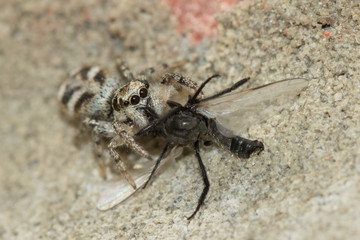
Behavior
These spiders exhibit unique behaviors that set them apart from many other arachnids. They are diurnal, meaning they are most active during the day. Their big, forward-facing eyes help them see depth well. This is key for judging distances when they jump onto prey. Zebra Spiders communicate through body language and leg movements, especially during mating rituals. They are curious. They often watch how people move before choosing to flee or stay.
Lifespan
Zebra Spiders typically have a lifespan of one to two years. However, this can vary depending on environmental factors and predator threats. Males generally have shorter lifespans compared to females, as they face increased vulnerability during mating season. In captivity, some individuals may live longer due to reduced risks from predators and harsh weather conditions.
Reproduction and Lifecycle
The mating process of Zebra Spiders is an intriguing display of courtship behavior. Males engage in a series of intricate leg movements and vibrations to entice females. If the female is receptive, mating occurs. Afterward, she lays her eggs in a silk sac, concealing it in a secure location such as beneath a rock or within a crevice. The young spiders then disperse by ballooning, releasing silk threads that the wind carries to new locations.
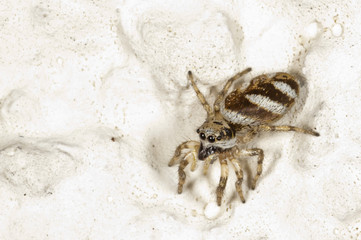
Predators
Zebra Spiders are fast, but they face numerous predators. These include birds, larger spiders, wasps, and lizards. Their small size makes them vulnerable. Nevertheless, they rely on quick reflexes, jumping abilities, and camouflage to evade threats. When in danger, they can quickly retreat or use their silk safety line to drop down to a safer spot.
Adaptations
Zebra Spiders have developed several adaptations that aid in their survival:
Exceptional vision: Their large, forward-facing eyes allow them to perceive depth accurately. They can detect even the slightest movements from both prey and predators.
Jumping ability: They can leap several times their body length by utilizing hydraulic pressure. This ability enables them to catch prey or evade threats.
Camouflage: Their striped patterns help them blend into their surroundings, making it more difficult for predators to spot them.
Silk safety lines: While they don’t use silk to capture food, they do produce silk lines. These lines assist them in landing safely after a jump.
Conservation Status
Zebra Spiders are not currently classified as endangered or threatened. Nonetheless, factors such as habitat destruction, pollution, and climate change could pose risks to their future survival.
The Zebra Spider is truly a remarkable creature. It demonstrates agility, intelligence, and resilience among arachnids. Its active hunting techniques, rather than relying on webs, make it one of nature’s most intriguing predators. This small yet formidable hunter highlights the vital role spiders play in our ecosystems.
